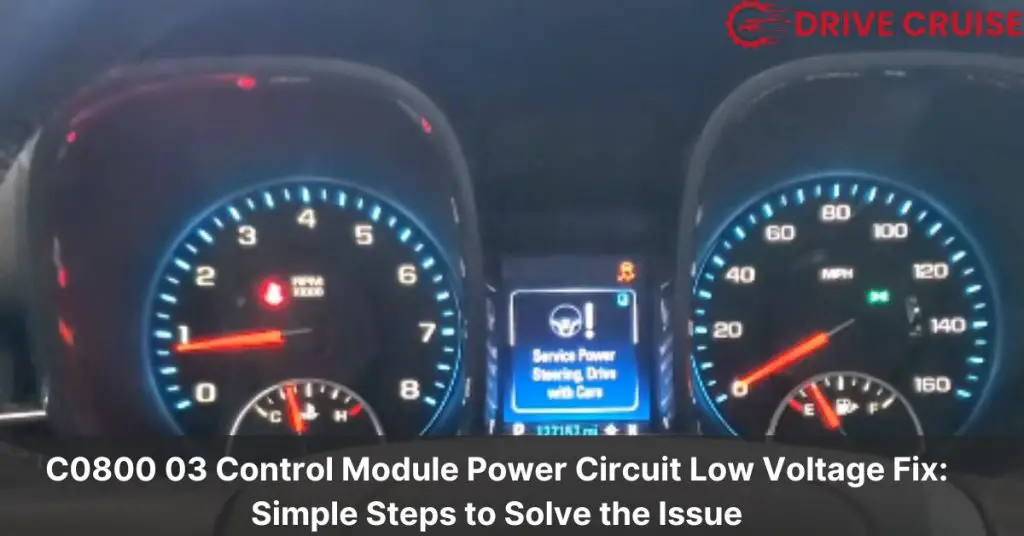Encountering a diagnostic trouble code (DTC) like C0800-03 can be frustrating, especially when it concerns a critical system like the control module power circuit. This code indicates a low voltage issue affecting the power supply to a control module in your vehicle. You may experience symptoms like poor connectivity, ABS light on, and fault codes displaying “C0800 03 Control Module Power Circuit Low Voltage.”
To fix the issue, you need to restore power to the vehicle’s control module (CM) when the voltage on the circuit powering the CM is too low. This issue can arise when there is an open or short in the electrical system supplying power to the control module. In this guide, we will explore possible solutions to fix the C0800-03 code and get your vehicle back on track.
Whether you are a professional mechanic or a DIY enthusiast, this guide will empower you to understand the C0800-03 code, troubleshoot the potential causes, and fix the issue. Keep reading to learn more about the control module power circuit and how to fix the C0800-03 code.
Demystifying the Code: C0800-03 Explained
If you’ve recently seen the code C0800-03 pop up on your dashboard, you may be wondering what it means. This code signifies a detected voltage issue within the power circuit supplying a control module in your vehicle. Here’s what you need to know about C0800-03:
Key Points to Remember:
- This code is generic and can apply to various control modules depending on the specific vehicle make and model.
- A low voltage condition can disrupt the proper functioning of the affected control module, potentially leading to other warning lights or performance issues.
When it comes to fixing the issue, the specific steps will depend on the make and model of your vehicle. However, some common causes of a low voltage condition include a faulty wiring harness, a malfunctioning power relay, or a weak battery.
If you’re experiencing other warning lights or performance issues in addition to the C0800-03 code, it’s important to have your vehicle inspected by a professional mechanic. They can diagnose the issue and provide a solution that will get your vehicle back to running smoothly.
If you’re a GM vehicle owner, you may see this code referred to as GM DTC C0800:03. Regardless of the specific terminology used, it’s important to address this issue promptly to avoid further damage to your vehicle’s control module power circuit.
Diagnosing the Culprit: Unveiling Reasons Behind C0800-03
If you’re experiencing a C0800-03 code, it’s essential to diagnose the issue correctly to avoid further complications. Several factors can contribute to this error code, including battery issues, loose or corroded battery connections, faulty ground connections, wiring issues, and internal control module faults.
Battery Issues:
A weak or failing battery can struggle to provide sufficient voltage to all electronic components, including control modules. If your battery is older or has been showing signs of weakness, it’s possible that it’s the culprit behind the C0800-03 code. A simple voltage test can help determine if your battery is the issue.
Loose or Corroded Battery Connections:
Loose or corroded battery terminals can impede proper current flow, causing voltage drops and potentially triggering the C0800-03 code. It’s essential to check your battery terminals for any signs of corrosion or looseness. If you notice any issues, clean or tighten the terminals as necessary.
Faulty Ground Connection:
A poor ground connection between the control module and the vehicle’s chassis can hinder proper grounding, leading to voltage irregularities. Check your ground connections for any signs of corrosion or looseness. If you notice any issues, clean or tighten the connections as necessary.
Wiring Issues:
Damaged or corroded wiring within the power circuit supplying the control module can cause voltage drops and trigger the code. Inspect the wiring for any signs of damage or corrosion. If you notice any issues, repair or replace the wiring as necessary.
Internal Control Module Fault (Less Likely):
In rare instances, the issue might lie within the control module itself. However, this is less common compared to the other causes. If you’ve exhausted all other possibilities, it might be time to consider replacing the control module.
Restoring Power: Solutions for Fixing C0800-03
If you’re experiencing a C0800-03 code, it indicates that there’s an issue with the power supply to the control module. Here are some solutions to help fix the problem:
Inspecting the Battery
The first step is to visually inspect your battery for signs of damage or corrosion. If the battery is nearing the end of its lifespan, consider replacing it with a high-quality unit recommended for your vehicle. A weak battery can cause voltage fluctuations, which can lead to the C0800-03 code.
Cleaning Battery Terminals
If the battery appears to be in good condition, the next step is to clean the battery terminals. Corrosion or grime buildup can interfere with the connection between the battery and the control module. Use a terminal cleaning tool and baking soda solution to clean the terminals thoroughly. Ensure a tight and secure connection of the terminals to the battery posts.
Checking Ground Connections
The ground connection point for the affected control module needs to be checked for signs of corrosion or looseness. Refer to a repair manual if needed to locate the ground connection point. Clean and tighten the ground connection as necessary.
Visual Wiring Inspection
Perform a visual inspection of the wiring harness supplying power to the control module. Look for any signs of damage, fraying, or corrosion in the wiring. If any issues are found, repair or replace the wiring as necessary.
Seeking Professional Help
If the above steps don’t resolve the issue, or if you suspect a more complex problem like internal control module failure, consulting a qualified automotive technician is crucial. They possess the diagnostic tools and expertise to pinpoint the exact cause and recommend appropriate repairs.
Preventing Future Darkness: Tips to Avoid C0800-03
The C0800-03 code can be a frustrating issue to deal with, but fortunately, there are steps you can take to minimize the likelihood of encountering this problem in the future. By following these practices, you can help maintain your vehicle’s electrical system and avoid costly repairs.
Regular Battery Maintenance
One of the most common causes of the C0800-03 code is a weak or failing battery. To prevent this issue, schedule regular battery inspections and clean the terminals periodically to prevent corrosion buildup. Corrosion can cause voltage drops, which can lead to low voltage issues in the control module. Keeping your battery terminals clean and free of corrosion can help maintain proper voltage levels and prevent the C0800-03 code from appearing.
Secure Battery Connections
In addition to keeping your battery terminals clean, it’s also important to ensure they are securely tightened. Loose connections can cause voltage drops and lead to low voltage issues in the control module. Make sure your battery connections are tightened to the manufacturer’s specifications to prevent this problem.
Adhere to Maintenance Schedules
Following your vehicle’s recommended maintenance schedule can help identify potential electrical issues early on, preventing them from escalating into more serious problems. Regular maintenance can also help ensure that your vehicle’s electrical system is functioning properly and prevent the C0800-03 code from appearing.
Conclusion: Knowledge is Power
By now, you should have a good understanding of what the C0800-03 code is, what may cause it, and some of the troubleshooting steps you can take to fix it. Remember that this code indicates that there is an issue with the power supply to the PCM, and it can be caused by various factors such as a weak battery, faulty wiring harness, or malfunctioning power relay.
To fix this issue, you can try some of the recommended solutions such as checking the battery voltage, inspecting the wiring harness, and replacing the power relay if necessary. It’s also important to keep your vehicle’s battery in good condition by regularly checking and maintaining it.
In addition to fixing the issue, it’s also essential to take preventative measures to ensure that the problem doesn’t occur again. This includes checking the battery voltage regularly, avoiding overcharging the battery, and keeping your vehicle’s electrical system in good condition.
Related Posts:







